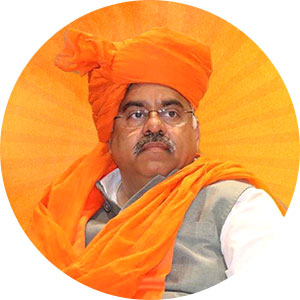Railway projects being launched in Odisha will significantly boost connectivity | PM Modi has given a new vision to J&K | Make every possible effort in publicizing schemes of Modi Govt
NARENDRA DAMODARDAS MODI
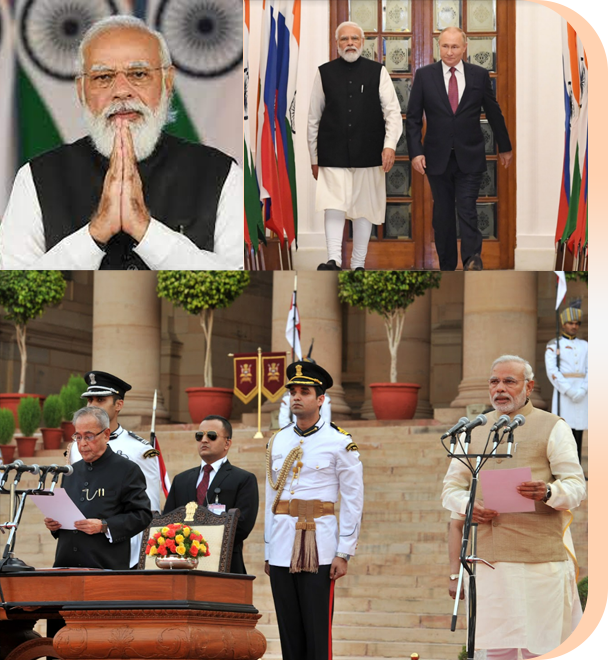
Narendra Damodardas Modi is the 15th Prime Minister of India. He assumed the PMO in May 2014. He was re-elected in the 17th Lok Sabha from Varanasi and led the Bhartiya Janata Party to a massive victory for a second term during 2019 Lok Sabha elections.
Political Journey
Shri Modi ji before entering into the political arena helped his father at their tea stall at Vadnagar Railway Station. He was introduced to RSS at an early age. During the time of Emergency in the country Shri Modi was appointed general secretary of the "Gujarat Lok Sangharsh Samiti", an RSS committee co-ordinating opposition to the Emergency in Gujarat. He became an RSS Sambhag Pracharak in 1978 where he supervised RSS activities in Surat and Vadodara. In 1979 Modi ji went to work for the RSS in Delhi. In 1985 he was assigned by the RSS to BJP. Modi ji’s magnificent management & remarkable work throughout the journey helped him grow in hierarchy. In 1987 shri Modi was elected organising secretary of the BJP's Gujarat unit. In 1990, he was named as the member of BJP’s National Election Committee. In 1995 Shri Modi ji was appointed as BJP National Secretary. His strategies were credited as essential to the BJP winning an overall majority in the 1998 elections after which Shri Modi was promoted to BJP general secretary in 1998.
Before becoming the prime minister of the country, he was the Chief Minister of Gujarat from 2001 to 2014. Ensuring three consecutive election victories for the party in Gujarat, Modi launched himself on to the national stage. Shri Narendra Modi he has single-handedly made BJP the most powerful party in the country. He is regarded as one of the most influential personalities in the world.
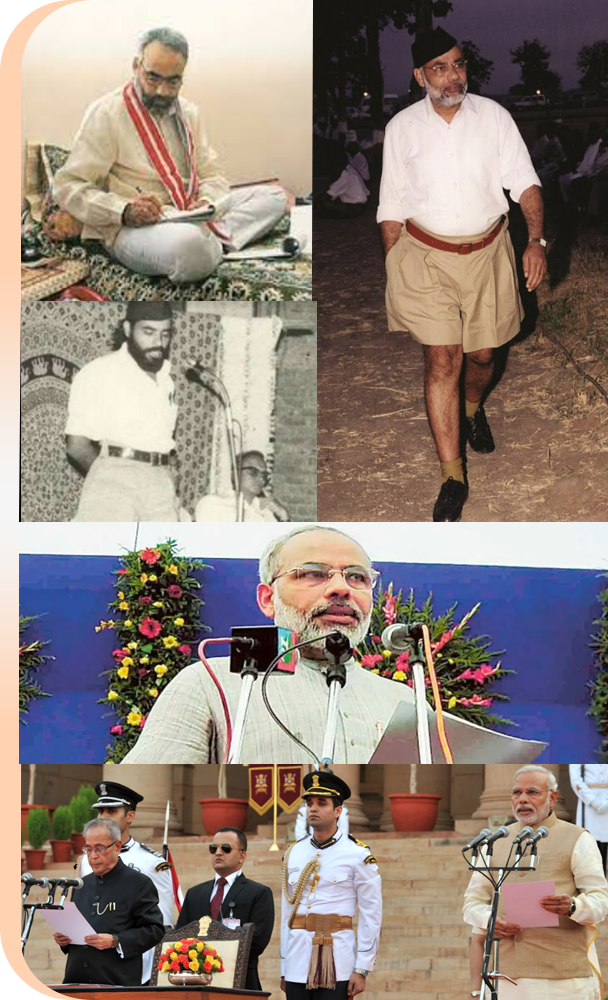
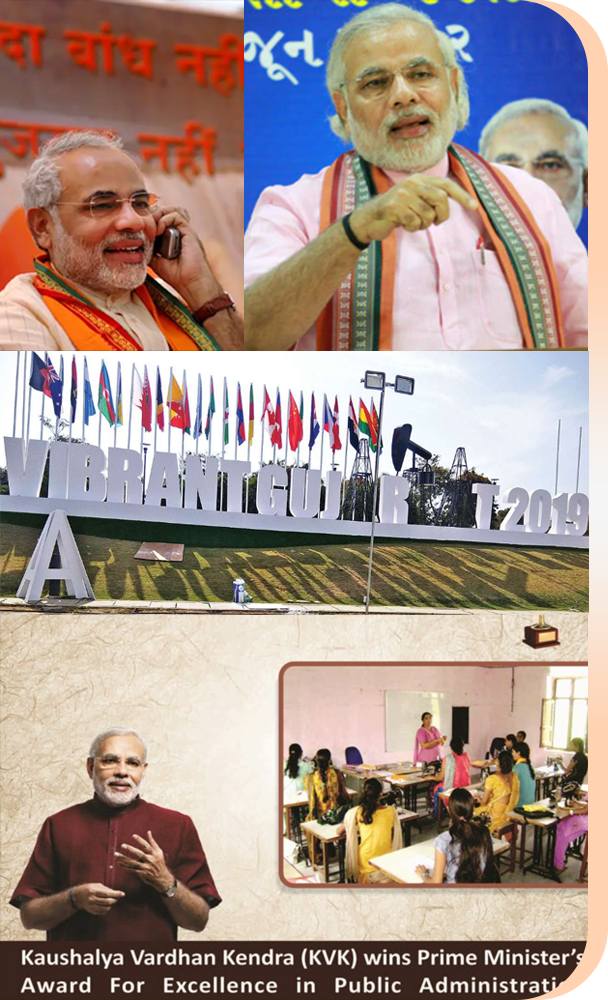
Served as the Chief Minister of Gujarat from 2001-2014
Narendra Modi was sworn in as Chief Minister in October 2001 and entered the Gujarat state legislature on 24 February 2002 by winning a by-election to the Rajkot constituency. When Narendra Modi took over as the Chief Minister Gujarat was undergoing the effects of a massive Earthquake. The floods, cyclone and droughts on the preceding years had also slowed the pace of development. Everyone thought the damage in Gujarat would take years to be undone but Narendra Modi and his team proved everyone wrong by putting Gujarat on the path to recovery and development in a record time of under three years. Gujarat’s development journey is characterized as development oriented, inclusive and participative. Decisions were not taken behind closed doors by select individuals but were taken after consulting all the stakeholders. Optimum use of technology was made to minimize corruption increase the pace of development. Under Modi ji, all three sectors: agricultural, industries & services grew exponentially & led way to Gujarat’s over all development.
Booming Healthcare And Education Sector
Shala Praveshotsav and Kanya Kelavani Drive:
Modi ji devoted attention towards Healthcare & education sector of the state. Since 2004 the Shala
Praveshotsav and Kanya Kelavani Drive are undertaken by every Government official including the Chief
Minister went to the villages of Gujarat asking parents to send their children to school. This has
received phenomenal results as the school dropout ratios have dropped considerably since the time when
Narendra Modi took office.
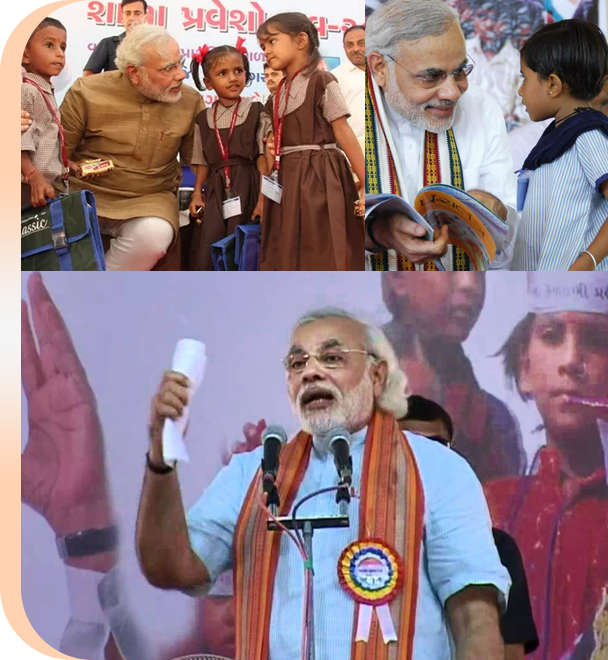
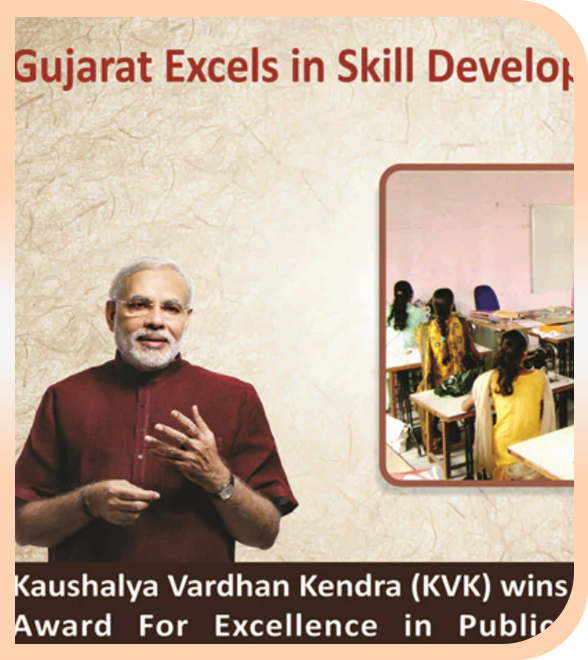
Skill Development Opportunities, Access To Kaushalya Vardhan Kendra.
A firm believer in youth-led development, Narendra Modi devoted a lot of efforts towards enhancing skill development among the youth. From building more ITIs, upgrading syllabus and infrastructure in the ITIs to integrating skill development programmes with technology, record number of steps have been taken for skill development among Gujarat’s youth. Infact, Gujarat’s Kaushalya Vardhan Kendras were awarded the Prime Minister’s Award for Excellence in Public Administration in 2013.
Krishi Mahotsavs & Soil Health Cards
They brought several services and opportunities at the doorstep of the farmers. The farmers received Soil Health Cards that gave them much needed guidance on enhancing their productivity. Special attention was also devoted to animal husbandry.
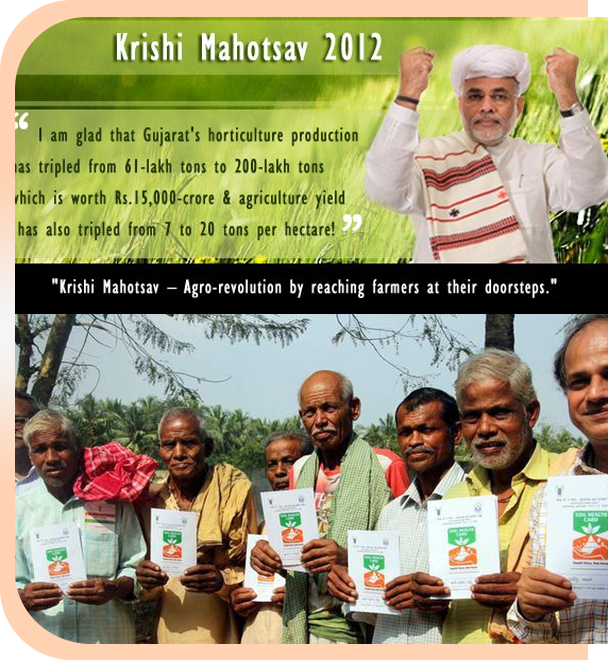
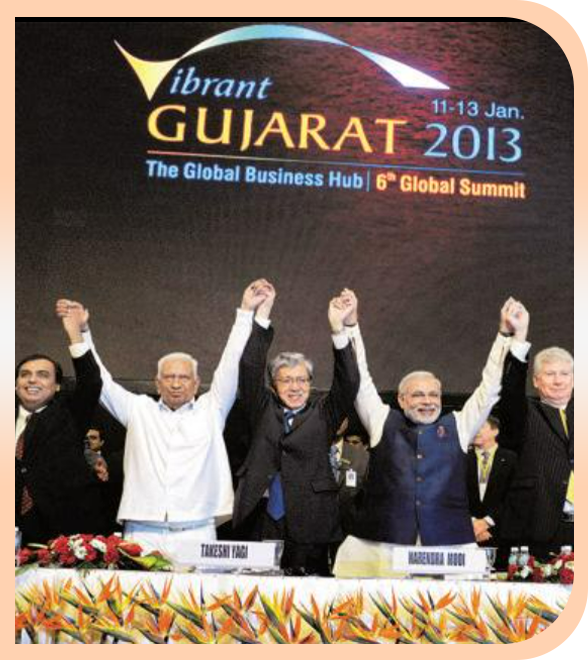
Vibrant Gujarat Summits
Industrial development scaled new heights in Gujarat since 2001. In 2003 the biennial Vibrant Gujarat Summits began that drew record investment to the state. At the same time, the land acquisition policy put in place by the Government ensures no injustice is done to the people where the industry is coming up.
Garib Kalyan Mela & Vanbandhu Kalyaan Yojana
Under Garib Kalyan Mela development reached the intended beneficiaries without any middlemen. In 2008 the Gujarat Government launched the Vanbandhu Kalyan Yojana, a special package devoted to development of the tribal communities. Today the package is worth Rs. 40,000 crore and has brought smiles on the faces of several people across Gujarat.
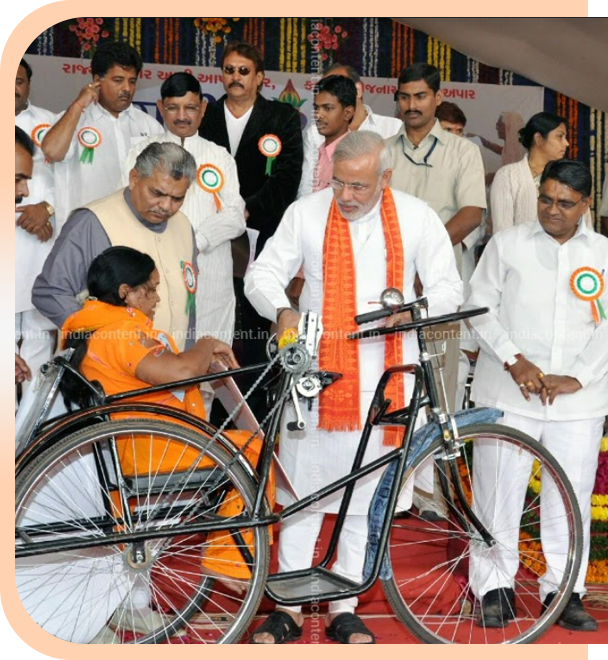
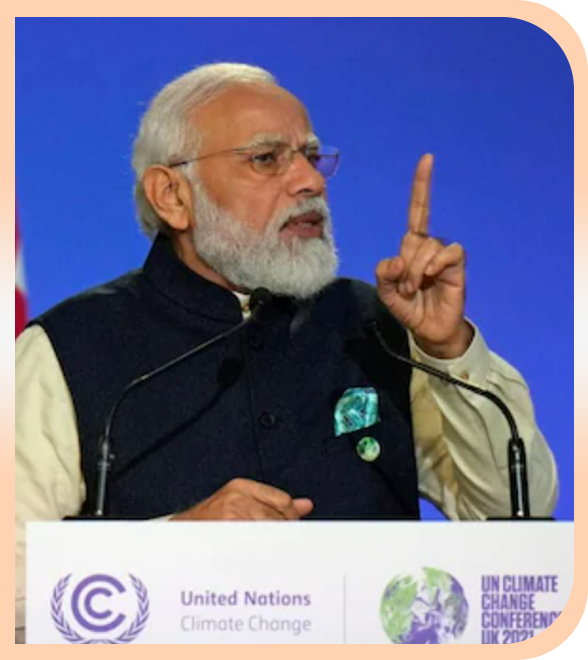
Active care for Climate change & Environment
PM Modi is deeply passionate about environmental causes. He has time and again called for closing of ranks to create a clean and green planet. As Chief Minister of Gujarat, Shri Modi created a separate Climate Change Department to create innovative solutions to climate change. Fully sensitive to the fact that climate change has made our planet prone to natural disasters, Shri Modi has brought a new approach to disaster management, harnessing the power of technology and the strength of human resources. As Chief Minister, he transformed Gujarat that had just been ravaged by a devastating earthquake on 26th January 2001. Likewise, he introduced new systems to combat floods and droughts in Gujarat that were internationally lauded.
Introduced evening courts
Through administrative reforms, Shri Modi has always given priority to justice for citizens. In Gujarat, he spearheaded the start of evening courts to ensure people’s issues are resolved.
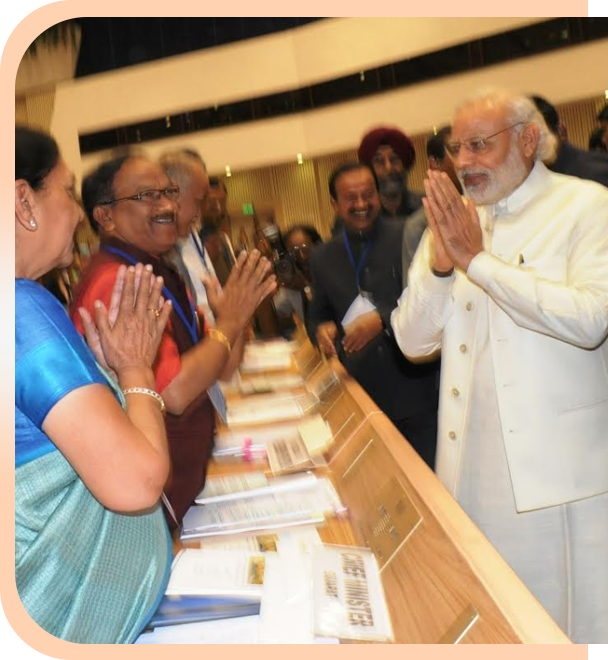
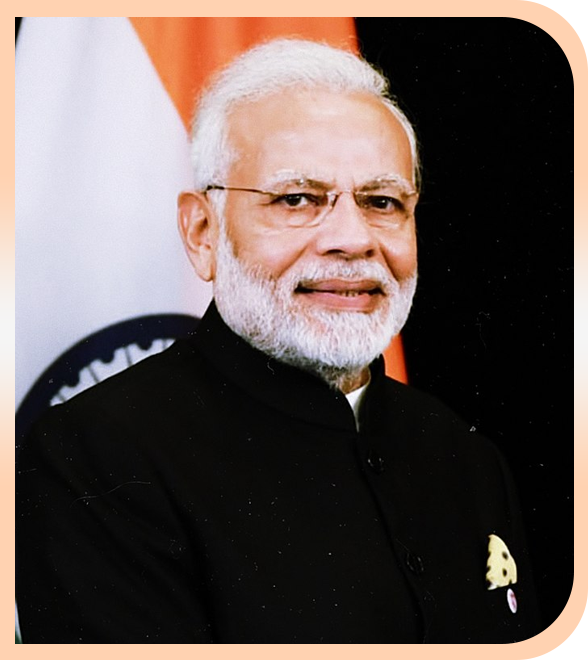
NARENDRA MODI: PRIME MINISTER OF INDIA
Shri Narendra Modi was sworn-in as India’s Prime Minister on 30th May 2019, marking the start of his second term in office. Shri Modi has previously served as the Prime Minister of India from 2014 to 2019. He also has the distinction of being the longest serving Chief Minister of Gujarat with his term spanning from October 2001 to May 2014. In the 2014 and 2019 Parliamentary elections, Shri Modi led the Bharatiya Janata Party to record wins, securing absolute majority on both occasions. Shri Modi ji’s ardent belief of contributing immensely to the motherland as led to an exponential growth of the country under his leadership. Since 2014 the country has witnessed manifolds of growth & development in all the spheres.
2014-2019
Swachh Bharat Mission:
On 2nd October 2014, Mahatma Gandhi’s Birth Anniversary, the PM launched ‘Swachh Bharat Mission’ a mass movement for cleanliness across the nation. The scale and impact of the movement is historic. Today, sanitation coverage has risen from 38% in 2014 to 99%. Several states and Union Territories have been declared open defecation free (ODF). Substantive measures been taken for a clean Ganga. The World Health Organisation has appreciated the Swachh Bharat Mission and has opined that it would save three lakh lives.
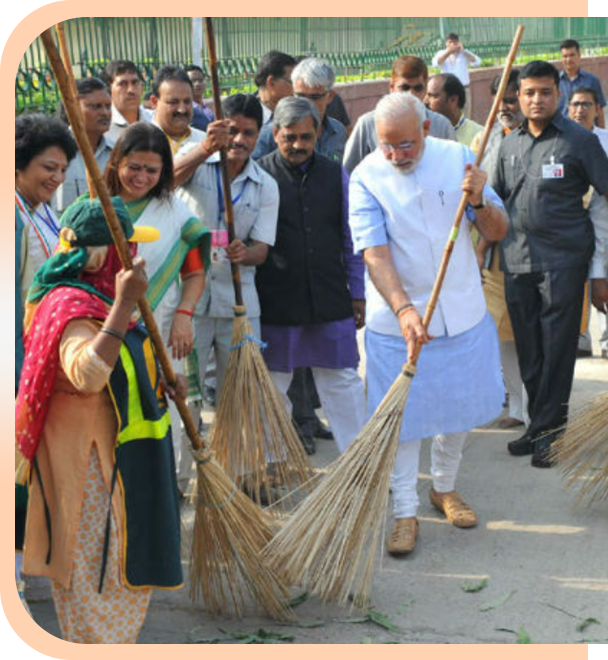
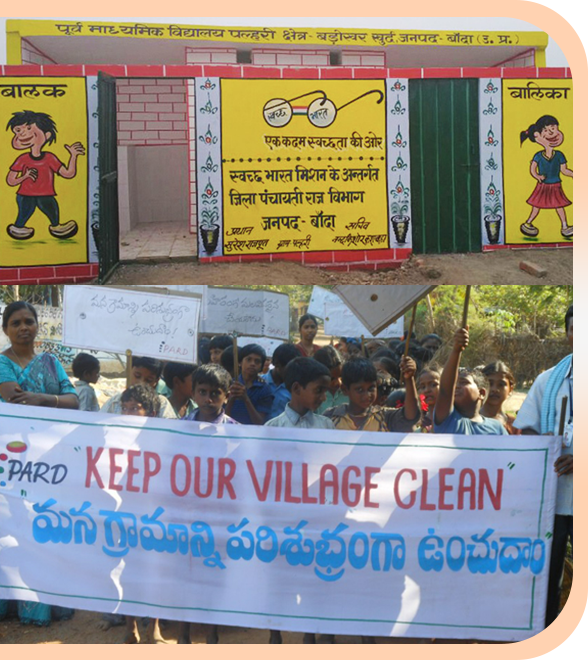
Impact of Swachh Bharat Mission in Rural India
Over 100 million toilets in rural India have been constructed under the mission. All villages, Gram Panchayats, Districts, States and Union Territories in India declared themselves "open-defecation free" by 2 October 2019, the 150th birth anniversary of Mahatma Gandhi. Under Swachh Bharat Mission (Gramin), 10.28 crore toilets have been constructed in 36 states plus UTs. 603,175 villages were declared open defecation free in five years. As a result of the Swachh Bharat Mission, 55 crore people changed their behaviour and started using toilets. With the attainment of Swachh Bharat, there has been a significant reduction in water and sanitation related diseases. The Swachh Bharat Mission has resulted in an annual profit of more than Rs. 50,000 per household in rural India.
Impact of Swachh Bharat Mission in Urban India
More than 30 crore people participated in the behaviour change campaigns under the world’s largest behaviour largest programme. 18% of people stated that the public toilets in their cities have improved after Swachh Bharat mission came into force. 32% people believe that the mission has made the citizens aware of cleanliness and overall civic sense. 22% believe that municipalities have become more responsive to complaints that are made regarding garbage collection, and street cleaning. Under the drive, more than 50 lakh household toilets have been constructed in the country. More than 81.5 thousand wards in urban areas now have 100% door to door collection of solid waste and nearly 65 thousand wards practice 100% segregation of waste at source. Of the nearly 150 thousand metric tonnes of solid waste generated in urban areas, 65% is being processed.
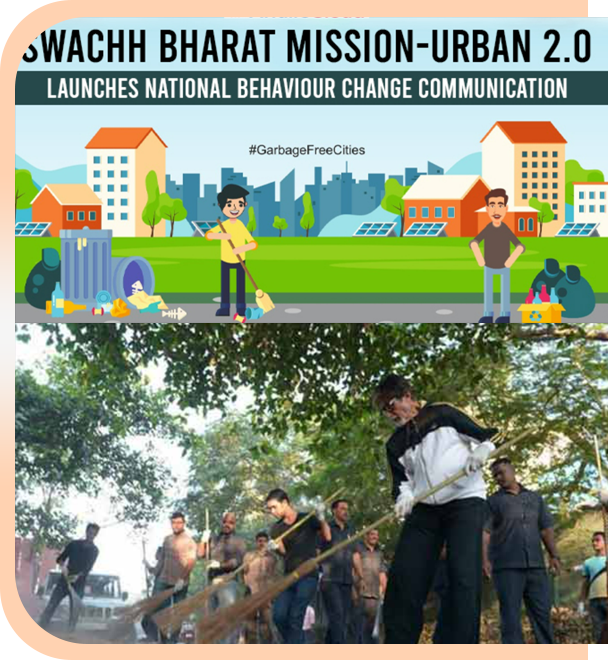
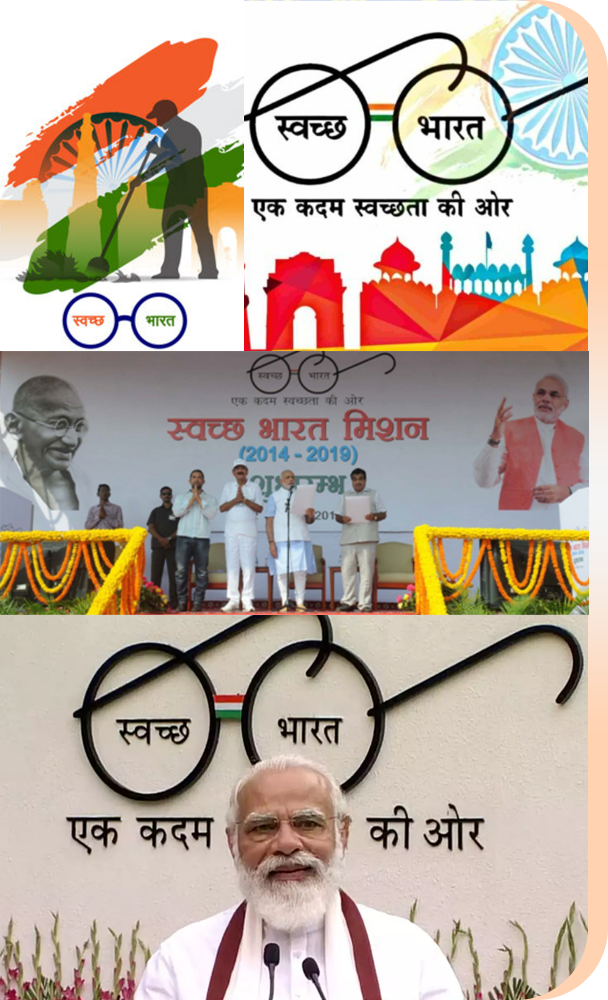
Clean India Movement: A mass movement
Shri Narendra Modi himself initiated the cleanliness drive at Mandir Marg Police Station. Picking up the broom to clean the dirt, making Swachh Bharat Abhiyan a mass movement across the nation, the Prime Minister said people should neither litter, nor let others litter. He gave the mantra of ‘Na gandagi karenge, Na karne denge.’ Shri Narendra Modi invited 9 people to join the cleanliness drive and requested them to call upon 9 more people to join the initiative. By inviting people to participate in the drive, the Swachhta Abhiyan has turned into a National Movement. A sense of responsibility has been ignited among the people through the Clean India Movement. With citizens now becoming active participants in cleanliness activities across the nation, the dream of a ‘Clean India’ once seen by Mahatma Gandhi has begun to get a shape.
Swachh Bharat Abhiyan has become a ‘Jan Andolan’ receiving tremendous support from the people. Citizens too have turned out in large numbers and pledged for a neat and cleaner India. Taking the broom to sweep the streets, cleaning up the garbage, focussing on sanitation and maintaining a hygienic environment have become a routine after the launch of the Swachh Bharat Abhiyan.
Provision of Toilets:
More than 100 million individual household level toilets have been constructed in rural areas, and 6 million household toilets in urban areas. In addition, nearly 6 million community and public toilets have also been constructed in the urban areas. Consequently, 4,234 cities and more than 600,000 villages across the country have declared themselves open defecation free. A study concluded that the construction of toilets under the program led to a reduction in incidence of sexual assault against women.
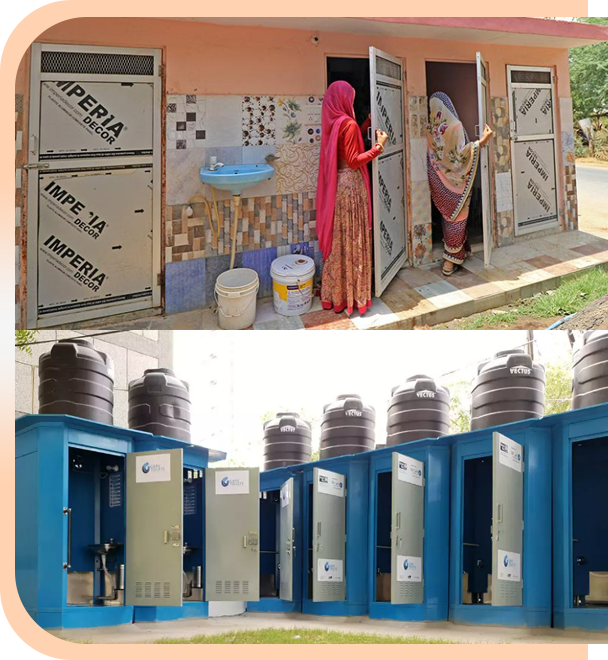
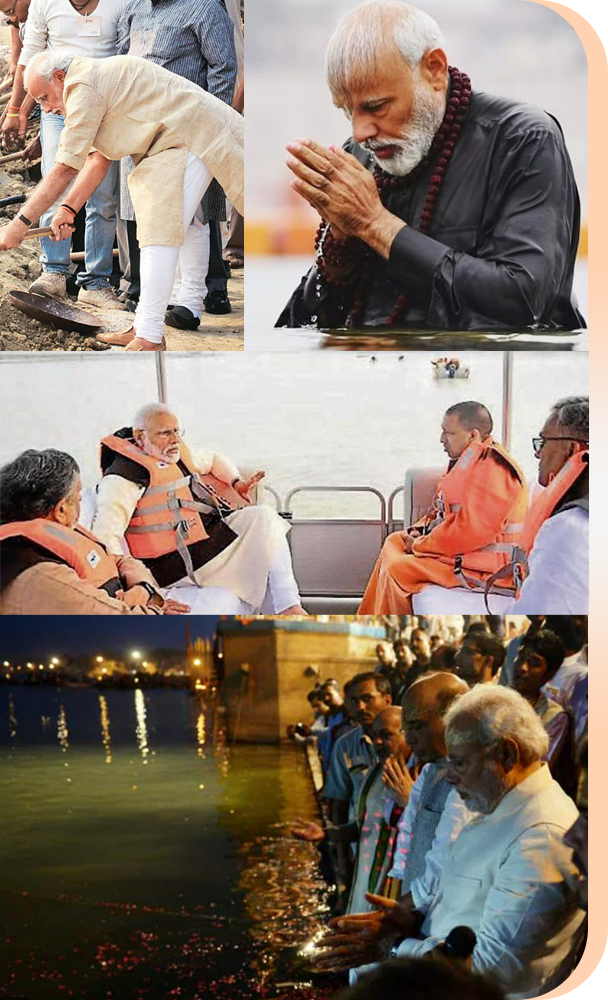
Clean Ganga Mission:
Under Swachh Bharat Abhiyan Shri Modi ji carried out a cleanliness drive in Varanasi. He wielded a spade near River Ganga at Assi Ghat in Varanasi under the Clean India Mission. Namami Gange Programme’, is an Integrated Conservation Mission, arising out of the concern for a Clean India, approved as ‘Flagship Programme’ by the Union Government in 2014 with an approx. budget of Rs.20,000 Crore to accomplish the objectives of effective abatement of pollution, conservation and rejuvenation of National River Ganga.
Government focused on involving people living on the banks of the river to attain sustainable results. Programme also focuses on involving the States and grassroot level institutions such as Urban Local Bodies and Panchayati Raj Institutions in implementation. The Namami Gange Programme will cover 8 states, 47 towns & 12 rivers under the project. Over 1,632-gram panchayats on the banks of Ganga shall be made open defecation-free. Interventions through Ghats and Riverfronts have been initiated to develop river-centric urban planning process & facilitate better connection with citizens. Expansion of sewerage covering infrastructure in 118 urban habitations on banks of Ganga and Development of rational agricultural practices & efficient irrigation methods are being encouraged under the Namami Gange Programme.
Beti Bachao Beti Padhao:
Our Mantra should be: ‘Beta Beti, Ek Samaan’ "Let us celebrate the birth of the girl child. We should be equally proud of our daughters. I urge you to sow five plants when your daughter is born to celebrate the occasion." -PM Narendra Modi to citizens of his adopted village Jayapur. Beti Bachao Beti Padhao (BBBP) was launched by the Prime Minister on 22nd January, 2015 at Panipat, Haryana. The objectives of this initiative include- Improve the child sex ratio, to ensure gender equality and women empowerment, to prevent gender-biased, sex selective elimination, to ensure survival and protection of the girl child, to encourage education and participation of the girl child. The National SRB Index has shown an upward trend from 918 (2014-15) to 934 (2019-20), an improvement of 16 points in five years. 422 districts out of 640 districts covered under BBBP have shown improvement in SRB from 2014-15 to 2018-19. The National Gross Enrolment Ratio of girls in secondary schools improved from 77.45 in 2014-15 to 81.32 2018-19. Proportion of schools with separate, functional toilets for girls rose from 92.1% in 2014-15 to 95.1% in 2018-19. 1st trimester ANC registration rate increased from 61% in 2014-15 to 71% in 2019-20.
Institutional deliveries rate spiked from 87% in 2014-15 to 94% in 2019-20. The movement did not just confine to the government but has become a mass movement. Artists, actors, industrialists, teachers, professors, doctors, all the people of the country joined in the movement through some or the other means. Various street plays served to the issue of child sex ratio, and BBBP movement. Women centric schemes were put into force to uplift the women of the nation, empower them to take onto their fields of interest & work towards building their bright future themselves. State of Haryana has been awarded Nari Shakti Puraskar 2015(Kannagi Devi Award) for work in progress on improving Child Sex Ratio and demonstrating improvement in Sex Ratio at Birth. National award for Beti Padhao was awarded to District Yamunanagar in the year 2016 on Balika Divas on 24.01.2017.
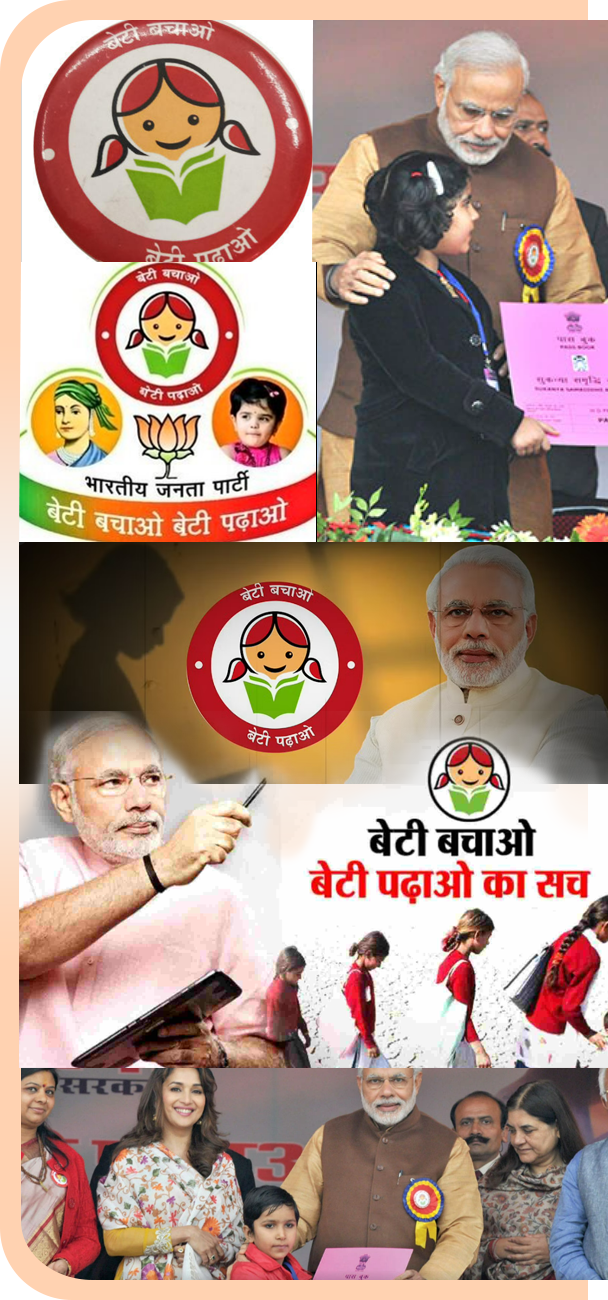
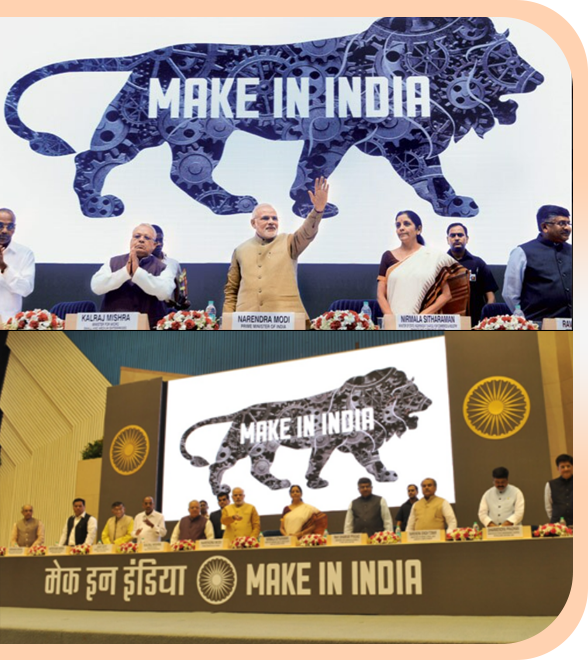
Make in India Programme:
PM Modi launched the ‘Make in India’ initiative to turn India into an international manufacturing powerhouse. This effort has led to transformative results. For instance, the number of mobile manufacturing units has risen from 2 in 2014 to 122 in 2019. India has made significant strides in ‘Ease of Doing Business’, improving its ranking from 142 in 2014 to 77 in 2019.
Digital India Programme:
Digital India is a flagship programme of the Government of India with a vision to transform India into a digitally empowered society and knowledge economy. The programme was launched on July 1, 2015 by Hon’ Prime Minister Shri Narendra Modi.
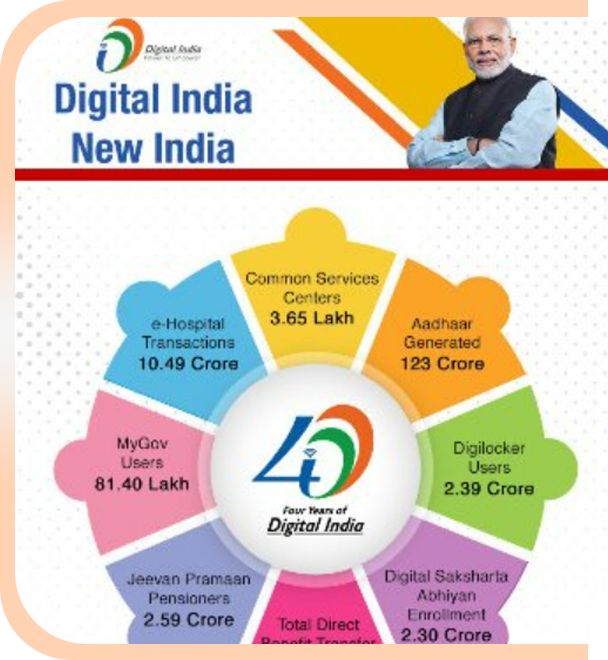
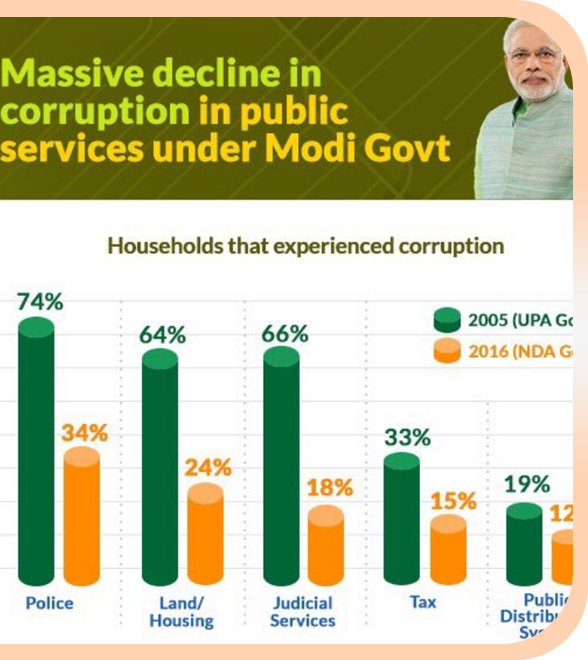
Decline in Corruption:
The advancement of the country into a Digital India has surely proved a boom in lowering the levels of corruption & malpractices in the country. The direct linkage of citizens with web portals, availability of easily accessible payment options, information sources and various other e-services has eliminated the space of middlemen that looted the public. Digital India has reduced paperwork & boosted the use of digital mediums thus increasing opportunities for growth not just nationwide but also across the world. Digital processes have made sure of efficiency in services & eliminated chances of wastage of time, money efforts for the people. It reduces malpractices such as bribing, etc and ensures equality by providing services to all in the most efficient manner. All can derive the benefit without standing in long queues & waiting for hours.
Common Service Centres
Under the Digital India programme, CSC 2.0 aims to establish a self-sustaining network of 2.5 lakh CSC centres in Gram Panchayats. CSCs have reached the grassroot level to increase the delivery of various electronic services to villages in India. CSCs have provided Government-to-Citizen (G2C) e-Services within the easy reach of citizen, by creating the physical service delivery ICT infrastructure. It helps in making a transparent service delivery mechanism and reducing citizens’ effort to visit government offices. The CSCs ensure provision of good quality & cost-effective internet access and various e-Services, related to various domains, such as, G2C, education, health, telemedicine, banking & finance as well as other private services. A highlight of the CSCs is that it allows web-enabled e-governance services in rural areas, including application forms, certificates, and utility payments such as electricity, telephone and water bills etc. As of 2020, there were 255,798 active CSC IDs and 687 districts had CSCs in India.
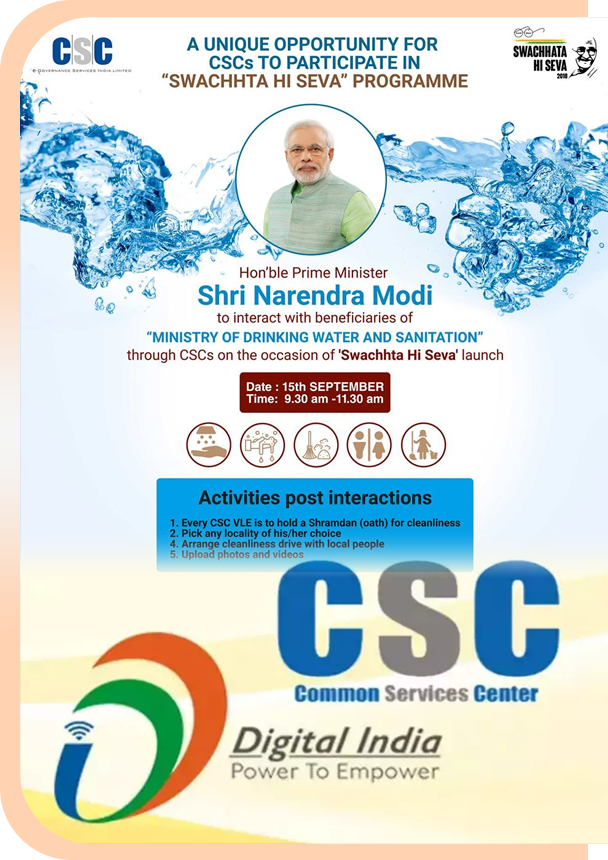
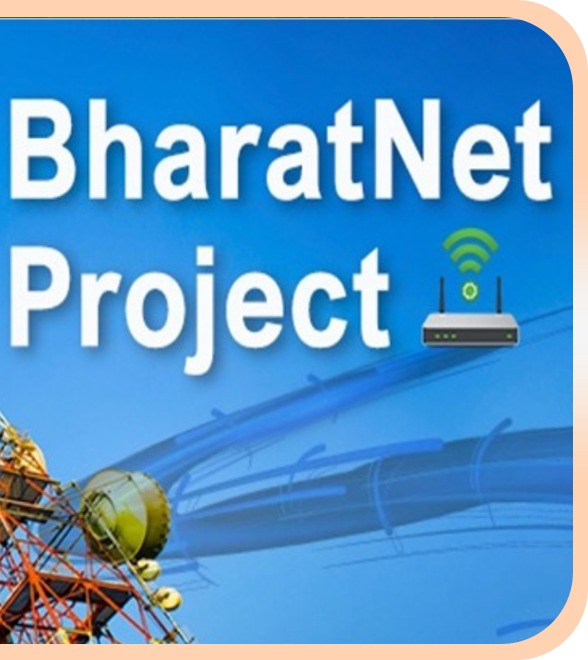
Bharat Net
The Bharat Net Project is world’s largest broadband connectivity programme for rural areas using optical fibre. It provides affordable broadband connectivity of 2 Mbps to 20 Mbps.The aim of the Bharat Net Project is to facilitate the delivery of e-health, e-governance, e-education, internet, e-banking, and other services to rural India. Bharat Net is a project undertaken by Government of India to digitally connect all the villages and Gram Panchayats of the country. The government has successfully upgraded the working in the country & provided facilities that were essentially required in the nation. The Parliament of India at the same time is being upgraded as well. Digital mechanisms are being sought to be introduced to make the workings even more efficient.
Pradhan Mantri Ujjwala Yojana:
The Pradhan Mantri Ujjwala Yojana, launched in 2016 provides free cooking gas connections to the poor. It has proven to be a major game-changer in providing smoke-free kitchens to over 7 crore beneficiaries, most of whom are women.
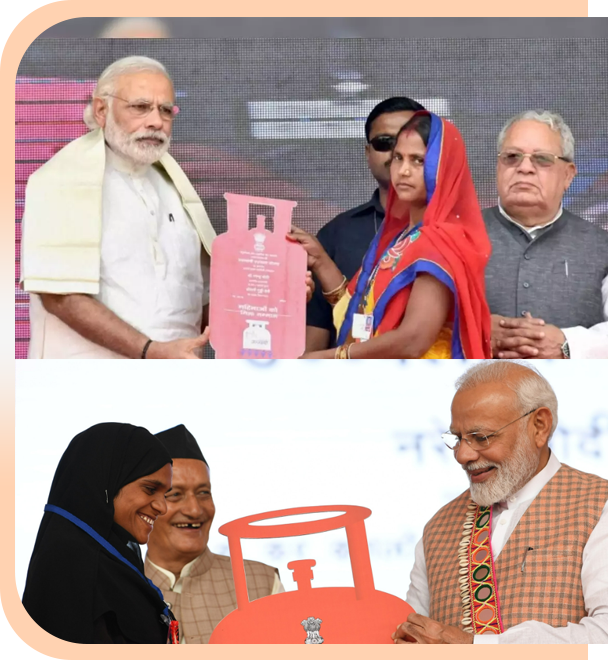
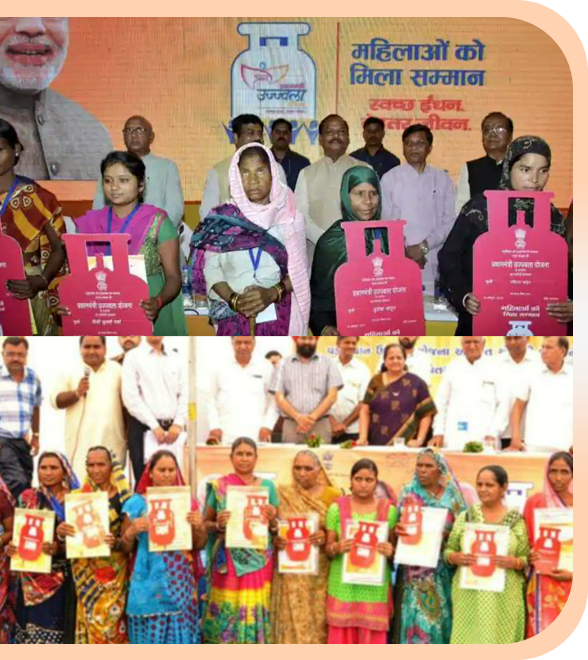
Pollution Free India
PMUY has surely proved to be an asset of the people, the country and the environment as a whole. The vision of providing smoke-free kitchen & clean cooking gas to households has majorly reduced the carbon footprints arising due to traditional methoda of cooking. Cleaner air, smoke free villages and decrease in the burnt residual waste has lead to a decline in the pollution levels.
Women’s Health
The key objective of Pradhan Mantri Ujjwala Yojana is to protect the health of women & children by providing clean cooking fuel and therefore, reducing their dependency on conventional cooking fuels such as coal and firewood, which will lower indoor smoke pollution and the risk of related diseases. Use of traditional methods like coal, petrol stoves, etc were a continuous alarm of harmful cooking methods as they caused major fire hazards, the smoke from these emitted poisonous gases that degraded health of females in long run and caused various breathing problems. PMUY has proven beneficial in protecting the women against the health hazards.

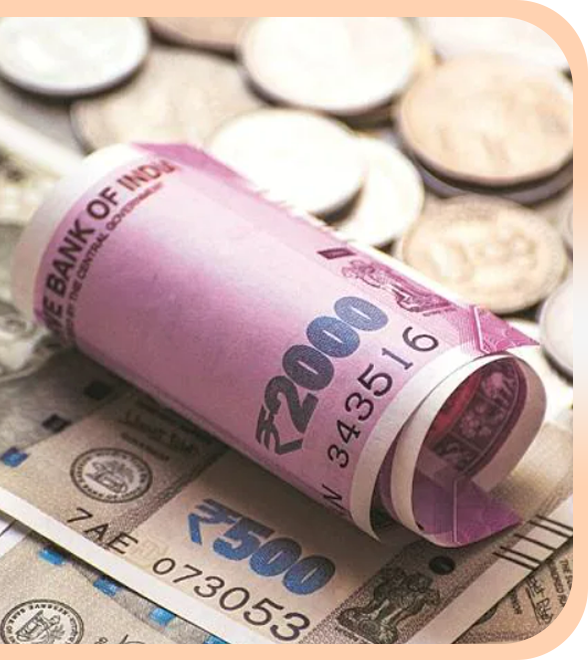
Demonetisation:
On November 8, 2016, Prime Minister Narendra Modi had announced ‘demonetisation’ to weed out black money from the country. The mov saw the currency notes of Rs 500 and Rs 1,000 denominations getting banned overnight. Demonetisation served as a masterstroke & stopped the circulation of duplicate currency in the economy. Corruption went low as the currency changed overnight. Usually, cash is the mode of transaction for anti-social & speculative activities. Demonetization curbed these activities. It also forced anti-social units to find ways to get rid of the old notes thus ensuring a hit to the terror activities taking place in the country. As a result of sudden demonetisation, there was better control over the unaccounted money in the economy. The number of taxpayers increased largely as the incomes were now under constant check & they could be accounted easily.
One Nation, One Tax:
The Government of India rolled out the GST during a historic session of Parliament in 2017, which has realised the dream of ‘One Nation, One Tax.’ All the tax payer services such as registrations, returns, payments, etc. are available to the taxpayers online, which makes compliance easy and transparent. GST ensures that indirect tax rates and structures are common across the country, thus increasing certainty and ease of doing business. Hidden costs of doing business have reduced. There is only one tax from the manufacturer to the consumer, leading to transparency of taxes paid to the final consumer. It has reduced cost of production and inflation in the economy, thus making the Indian trade and industry more competitive, domestically as well as internationally.
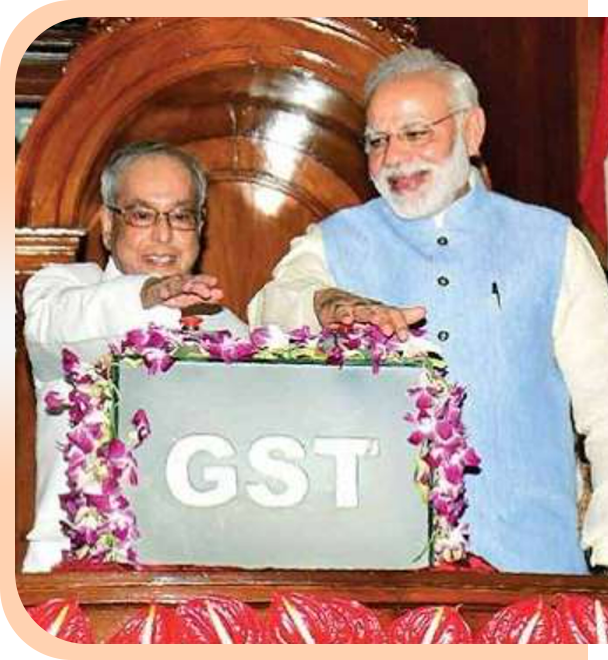
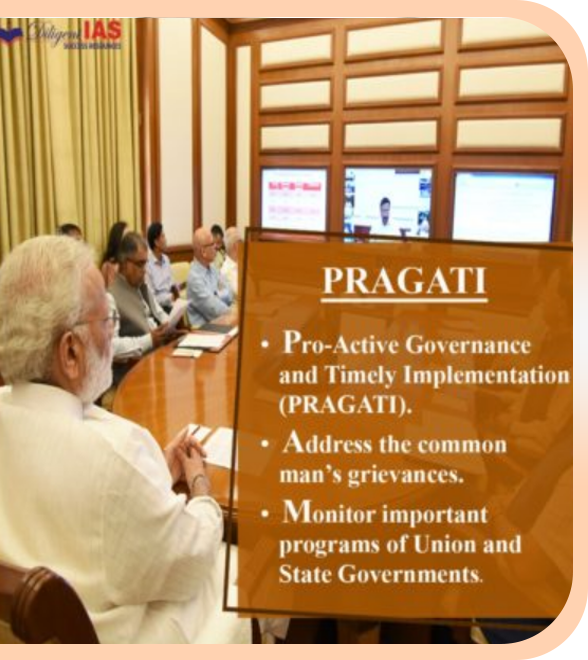
PRAGATI (Pro-Active Governance and Timely Implementation)
To ensure people’s issues are resolved Modi ji began PRAGATI ((Pro-Active Governance and Timely Implementation) at the Centre to expedite pending projects that were delaying growth. It has resulted into the improvement of Citizen centric services & Real time schemes tracking system. Due to the increased efficiency & improvement it has led to a massive overall socio and economic development through good governance. It provides the benefit of absolute good governance with limited government use.
International Day of Yoga:
Narendra Modi’s clarion call for marking a day as ‘International Day of Yoga’ received an overwhelming response at the UN. In a first, a total of 177 Nations across the world came together and passed the resolution to declare 21st June as the ‘International Day of Yoga at the UN.’ Recognition of the ancient Indian practice on International Level and dedicating 21st June as Yoga day has led to a strong identification of India on the world stage. This initiative undoubtedly promotes the age old, highly worshipped & practiced culture at international level. It has encouraged people to follow a healthy lifestyle along with including yogic practices in life to lead a healthy, spiritual, mentally fit life full of growth & satisfaction.
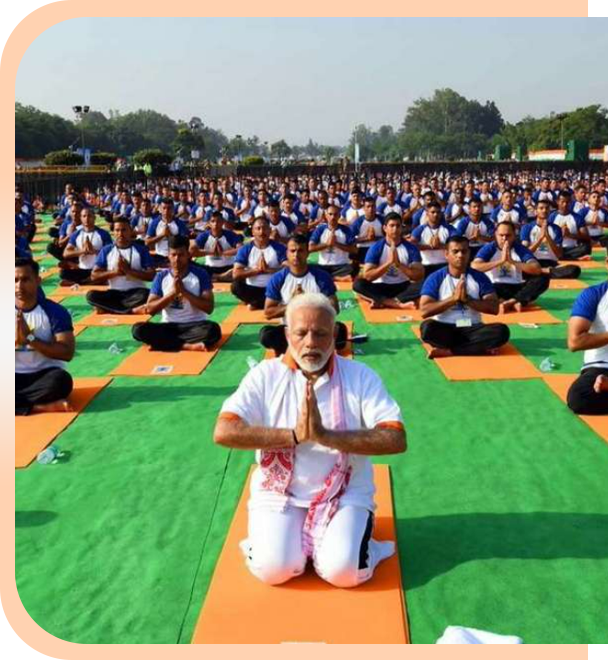
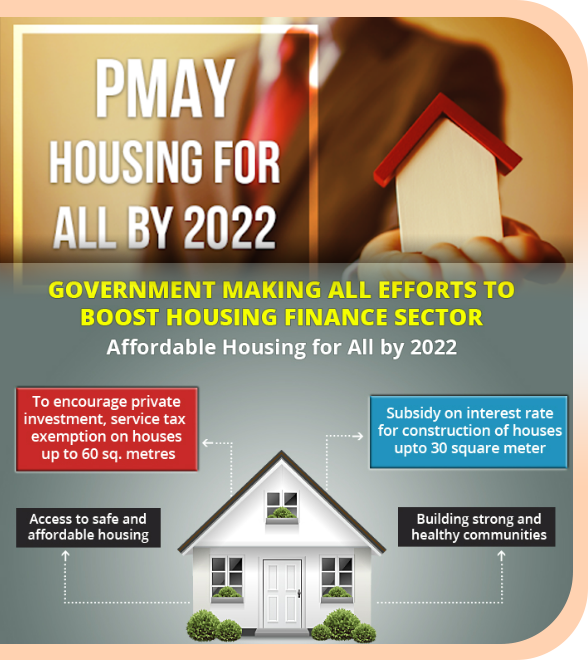
Housing for All Vision:
Shri Modi believes that no Indian should be homeless and to realise this vision, over 1.25 crore houses were built between 2014 and 2019. The pace of house construction remains as quick to fulfil the PM’s vision of ‘Housing for All’ by 2022.
PMAWY
In 2015, the Indian government introduced the Pradhan Mantri Awas Yojana (PMAY) to provide affordable housing to all citizens by 2022. Through this credit linked subsidy scheme (CLSS), the government aimed to provide its beneficiaries an interest subsidy to avail loans to purchase or build a house. The scheme was launched to aid the middle-income community, economically weaker sections (EWS) and low-income groups (LIG). Depending on the areas it serves, the scheme is divided into two sections, Pradhan Mantri Awas Yojana-Urban (PMAY-U) and Pradhan Mantri Awas Yojana Gramin (Pradhan Mantri Awas Yojana Rural). Introduced in 2016, PMAY-U aimed to provide ‘Housing for All by 2022’ by establishing 1.12 crore houses for urban poor across the country over the next seven years (between 2015 and 2022). In January 2021, under the PMAY-G, Prime Minister Mr. Narendra Modi announced to provide financial assistance worth Rs. 2,691 crore to 6.1 lakh beneficiaries in Uttar Pradesh. As of April 2021, 1.37 crore houses have been built across the country under the scheme.
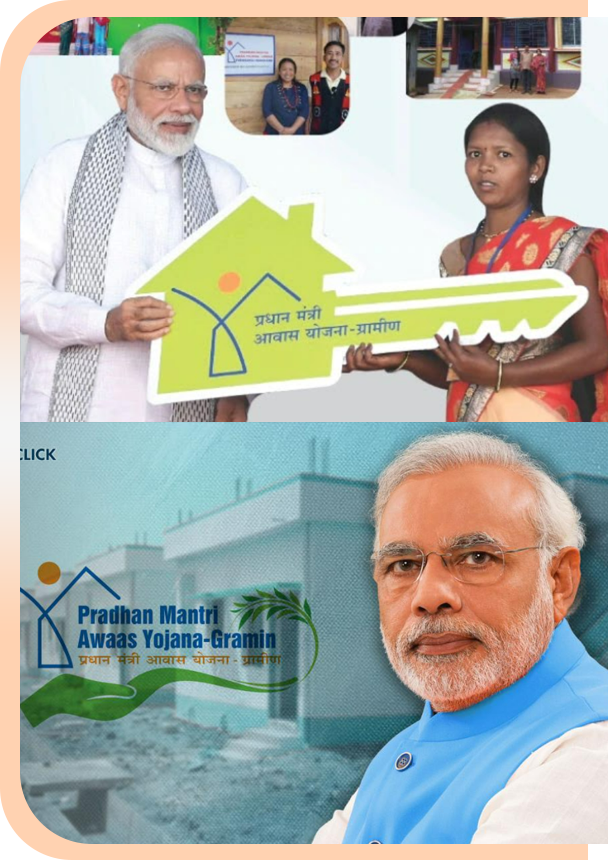
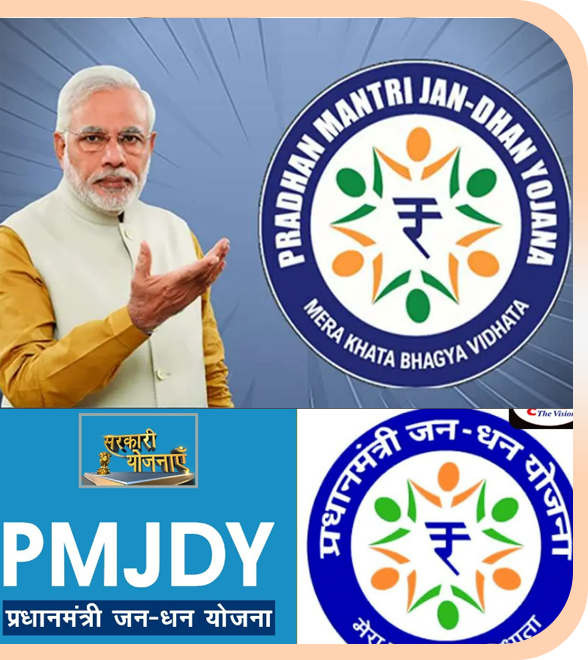
Pradhan Mantri Jan Dhan Yojana
Prime Minister launched the Pradhan Mantri Jan Dhan Yojana, that aimed at opening bank accounts for every Indian. Today more than 35 crore Jan Dhan accounts have been opened. By introducing Jan Dhan Mobile Banking the scheme has enabled people to maintain one mobile number across different telecom circles, across the nation will help streamline infrastructure for direct tranfer of benefits to intended audience, enable & enhance electronic delivery of services and increase adoption of e-Services among people.
Easy Banking for All
Under the PMJDY, the aim is to create consumer interest in banking and improve the BFSI infrastructure. The PMJDY encourages use of banking by linking several govt. facilities with these accounts. Limited documentation and single form were the only requirements to open accounts under the PMJDY scheme. People with no ID documents can also open accounts with limits of deposits, credit and withdraw limit also contributed to the success of the scheme.
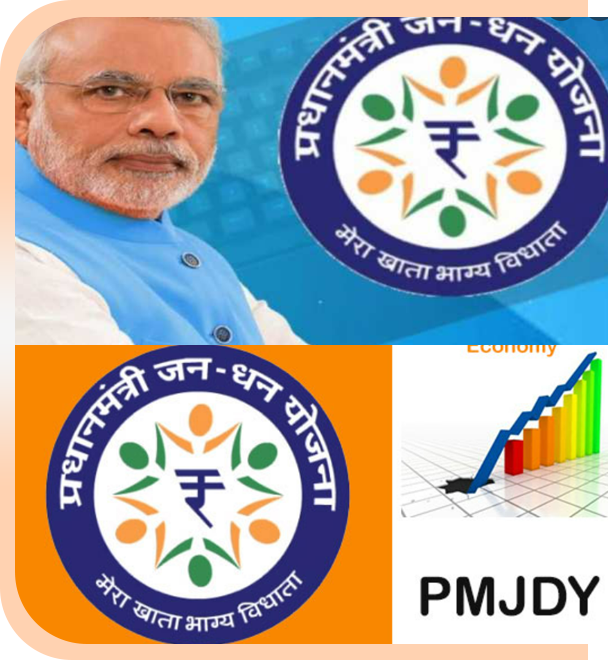

Direct Benefit Transfers
PMJDY accounts are eligible for Direct Benefit Transfer , Pradhan Mantri Jeevan Jyoti Bima Yojana, Pradhan Mantri Suraksha Bima Yojana, Atal Pension Yojana, Micro Units Development & Refinance Agency Bank scheme. The scheme encourages use of banking by linking several govt. facilities with these accounts. Between April and June 2020 the Indian govt. released three tranches of US$1.3 billion each to 200 million women under the Pradhan Mantri Garib Kalyan Yojana. In 2020 the govt. transferred Rs. 8 billion through PMJDY accounts to the beneficiaries of Pradhan Mantri Awas Yojana. 14 ministries and departments are chanelling their subsidy payments through 57 national programmes into PMJDY accounts
Fasal Bima Yojna
Launched in 2016, the Pradhan Mantri Fasal Bima Yojana is a large-scale crop subsidy insurance scheme which was made to safeguard the farmers. This scheme was designed in accordance with One Nation–One Scheme and replaces three older initiatives—Modified National Agricultural Insurance Scheme, Weather-based Crop Insurance Scheme and the National Agricultural Insurance Scheme by including their best features and removing shortcomings to improve insurance services available to farmers. This scheme is being administered by the Department of Agriculture, Cooperation and Farmers’ Welfare under the Ministry of Agriculture. When the scheme was launched in 2016, a total of 5.8 crore farmers were insured, where 75% farmers received mandatory coverage as per the SAO loan allocations and 25% farmers voluntarily chose insurance.
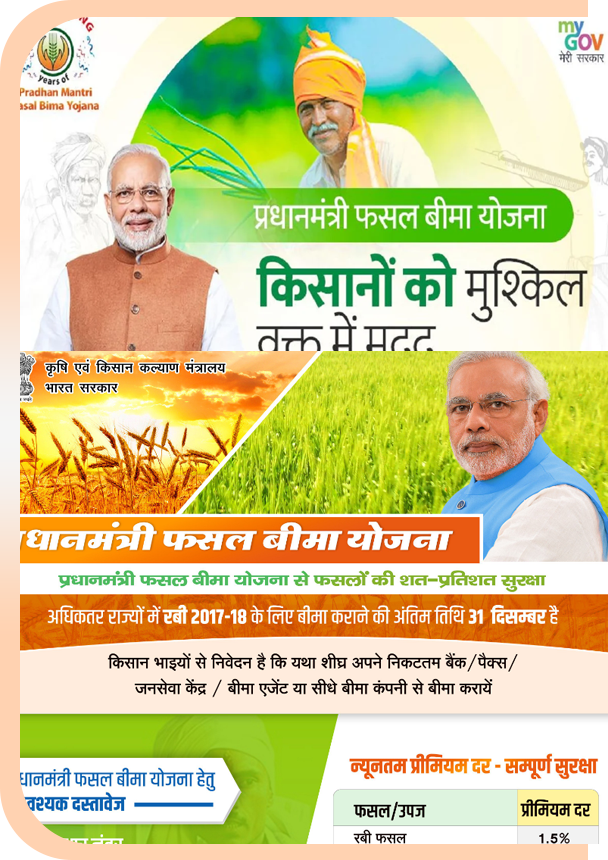
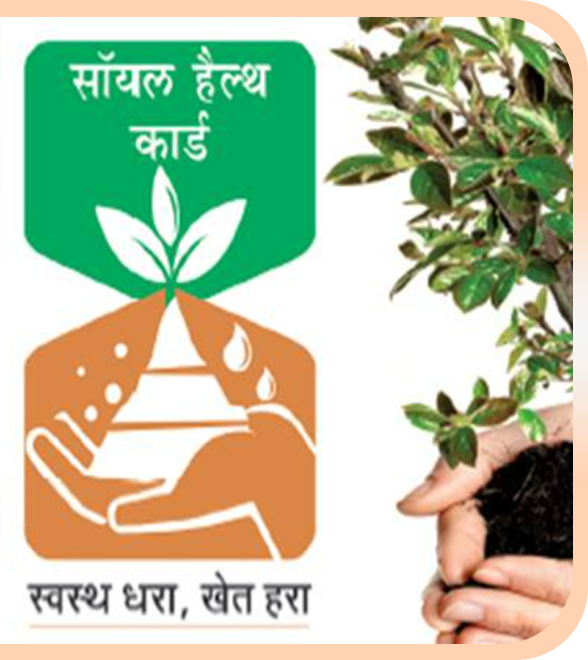
Soil health card
Soil Health Card scheme is introduced by Govt of India. It is being implemented through the Department of Agriculture of all the State and Union Territory Governments. A Soil Health Card is used to ascertain the current status of soil health and when used over time, to determine changes in soil health that are affected by land management. A Soil Health Card shows soil health indicators and related detailed terms. The indicators are based on the farmers practical experience and knowledge of local natural resources.
PM Mudra Yojana
In April 2015, the Indian government introduced the Pradhan Mantri MUDRA Yojana (PMMY) to provide loans of up to Rs. 10 lakh to non-corporate, non-farm small/micro enterprises. Through PMMY, the government aims to support and fund small business owners to help them generate/create jobs in sectors such as manufacturing, services, retail and agriculture & allied industries.The scheme was developed to aid unbanked citizens by getting them into mainstream banking, assisting them with microcredits and empowering them to become self-reliant. In the last five years (from 2015 to 2020), the PMMY programme has benefited 24.48 crore loan accounts, with a sanction of Rs. 12.30 lakh crore (US$ 166.56 billion), allowing small business owners to contribute to the country's overall economic development. MUDRA loans generated 11.2 million additional jobs between 2015 and 2018, wherein 55% were self-employed jobs and 45% comprised new jobs, which were created in existing businesses. In the same period, women workforce accounted for 62% of the total estimated increase in jobs in India.
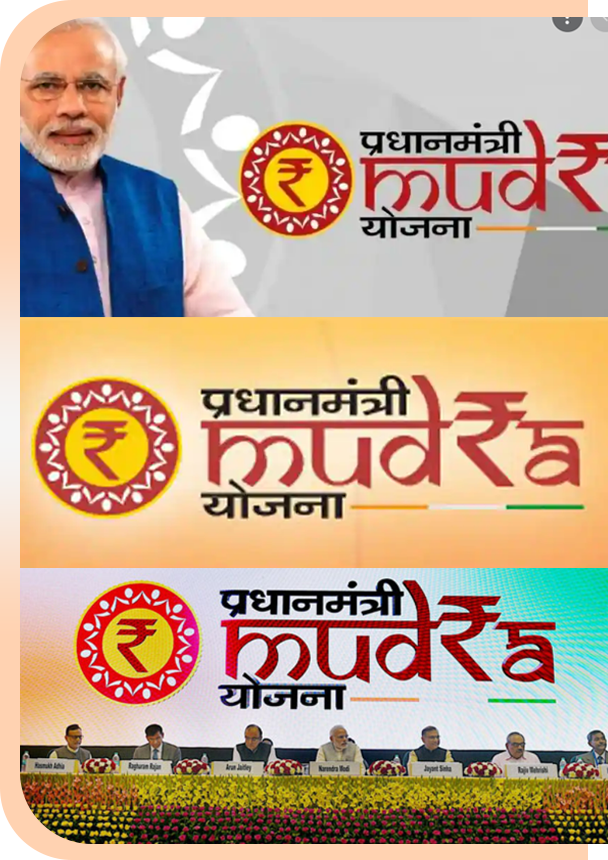
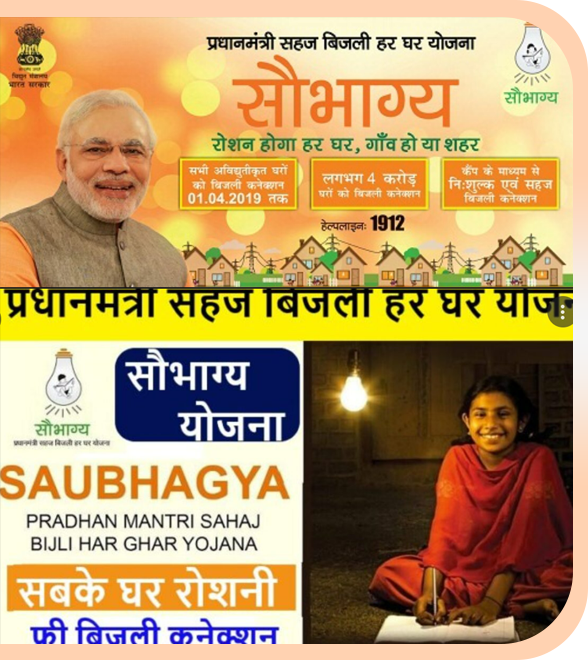
Saubhagya Yojna
The Prime Minister, Shri Narendra Modi launched the Pradhan Mantri Sahaj Bijli Har Ghar Yojana - Saubhagya, at Deendayal Urja Bhawan, in New Delhi on September 25, 2017. Scheme aims to achieve 24x7 power for all by by providing electricity connection to each household across the country. Under the scheme subsidy shall be provided on equipments like transformers, wires and meters. Ministry of Power would be the implementing authority of the scheme & Power connection are provided in both rural and urban areas of the country.
Aaushyman Bharat
In 2018, the Government of India launched the ‘Ayushman Bharat’ scheme to make healthcare services more accessible and affordable to citizens and aid the country in achieving its target of universal health coverage by 2030. As of April 2021, 75,532 Ayushman Bharat Health and Wellness Centres were working across the country and registered a footfall of more than 44.24 crore, of which more than 23.8 crore women have accessed care at these centres. Under the Ayushman Bharat’s Pradhan Mantri Jan Arogya Yojana 1.59 crore hospital admissions worth Rs. 19,714 crore were registered, as of February 2021. 136,172,075 E-cards Generated, 15,885,194 Authorised Hospital Admissions as of Feb 2021.
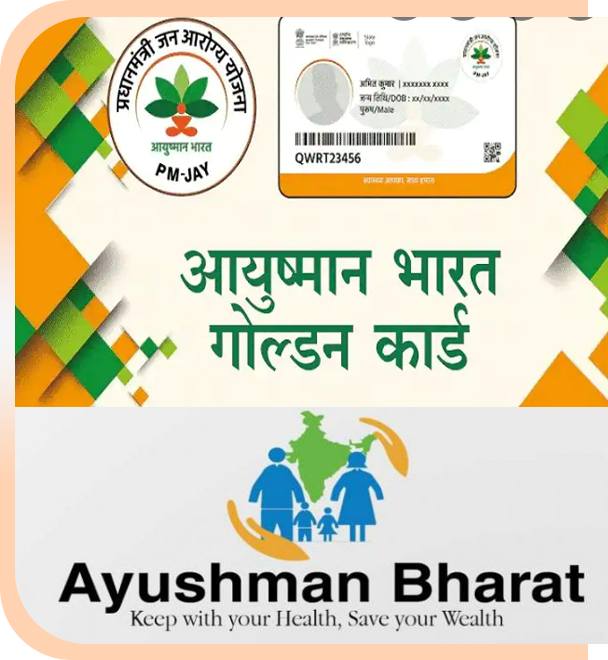
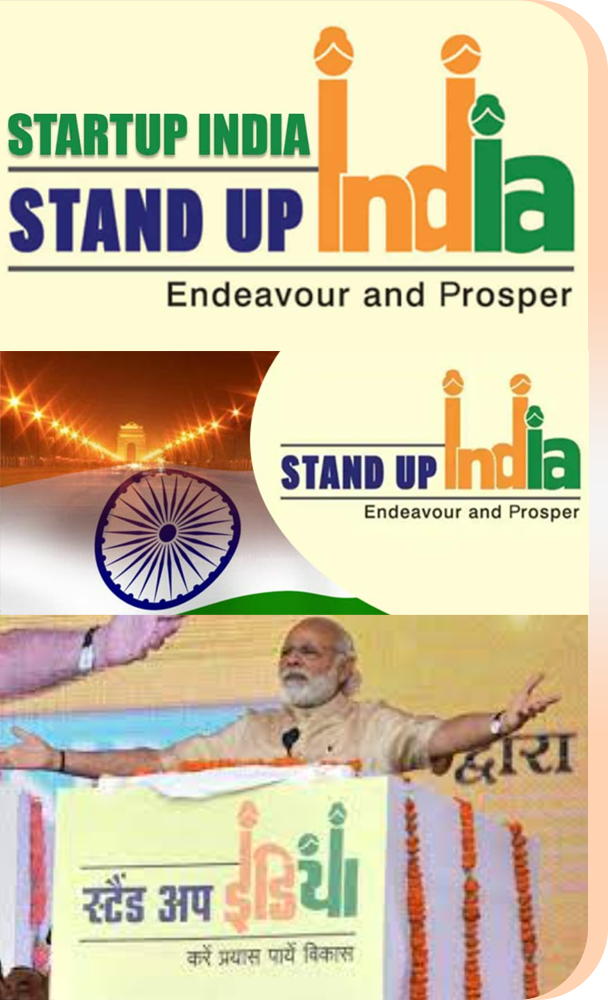
Standup India
Stand Up India aims to empower every Indian and enable them to be independent. The programme recognises challenges faced by the Scheduled Caste (SC), Scheduled Tribe (ST) and women entrepreneurs in setting up enterprises, obtaining loans and other support needed from time to time for succeeding in business. The programme, also aims to create an environment that facilitates and continues to provide a supportive space for doing business.
The objective of the scheme is to facilitate composite bank loans (including term loan and working capital) between Rs. 10 lakh (US$ 14,000) and Rs. 1 crore (US$ 140,000) to at least one SC or ST borrower and one woman borrower per bank branch (without collateral) for setting up a Greenfield enterprise. This enterprise can be set up in either of these sectors—manufacturing, services, agri-allied activities or trading. In case of non-individual enterprises, at least 51% of the shareholding and controlling stake should be held by either an SC/ST or women entrepreneur. Banks have sanctioned Rs. 25,586 crore (US$ 3.41 billion) to about 114,322 beneficiaries under the Stand Up India Scheme in the last five years since inception for promoting entrepreneurship among women and SCs & STs. As of March 23, 2021, the scheme has benefited 93,094 women entrepreneurs with an outstanding loan of Rs. 21,200 crore (US$ 2.83 billion). About 16,258 entrepreneurs belonging to the SC category have received loans worth Rs. 3,335.87 crore (US$ 445.73 million) and 4,970 entrepreneurs from the ST category have received loans worth Rs. 1,049 crore (US$ 140.16 million).
2019-Present
The Citizenship Amendment Act
The Citizenship (Amendment) Act, 2019 aims to facilitate grant of citizenship to migrants belonging to Hindu, Sikh, Buddhist, Jain, Parsi or Christian community from Pakistan, Bangladesh and Afghanistan who entered into India on or before the 31.12.2014 and who have been exempted by the Central Government by or under clause (c) of sub-section (2) of section 3 of the Passport (Entry into India) Act, 1920 or from the application of the provisions of the Foreigners Act, 1946 or any rule or order made thereunder. The Citizenship (Amendment) Act, 2019 has been notified on 12.12.2019 and has come into force w.e.f. 10.01.2020.
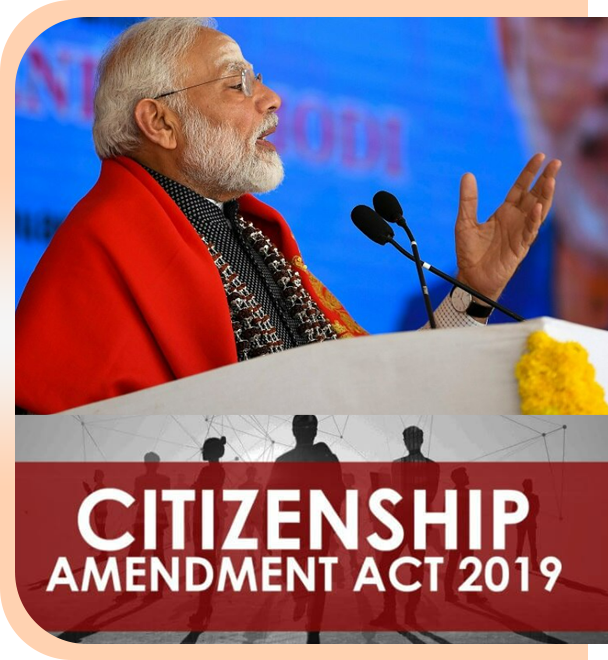
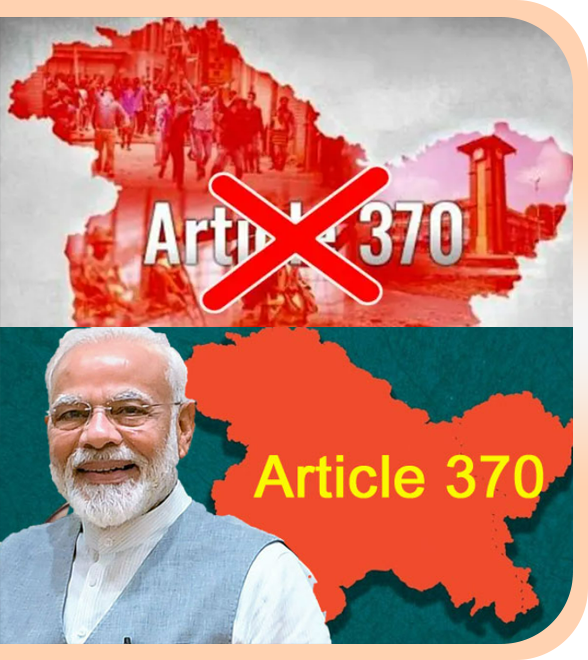
Scraping of Article 370:
For 70 years, people of India have harboured this aspiration in their hearts that Kashmir must be an integral part of India. Article 370 was the only roadblock to realize this goal. Home Minister thanked the Prime Minister for this historic step to remove this roadblock for ever.
Aatma Nirbhar Bharat Abhiyan:
The PM has announced Rs. 20 Lakh crore economic package under the ‘AtmaNirbhar Bharat Abhiyaan’, to aid our country out of the Covid-19 Crisis. Vaccine Maitri was an initiative undertaken by the Indian government to provide COVID-19 vaccines to countries around the world.The government started providing vaccines from 20 January 2021. As of 21 February 2022, India had delivered around 16.29 crore doses of vaccines to 96 countries. In this, 1.43 crore doses were gifted to 48 countries by the Government of India and remaining 10.71 crore were supplied by the vaccine producers under its commercial and 4.15 crore were supplied by COVAX obligations. Within 60 days of the mission’s launch, India’s domestic producers were able to generate a supply of personal protective equipment (PPE) kits, demonstrating the country’s self-sufficiency in PPE kits. In January 2020, the country launched the world’s largest vaccination drive with two ‘Made in India’ vaccines—Covaxin and Covishield—and demonstrated its determination to become self-reliant. Domestic supplies: As of April 14, 2021, India’s total vaccination coverage crossed 110 million.
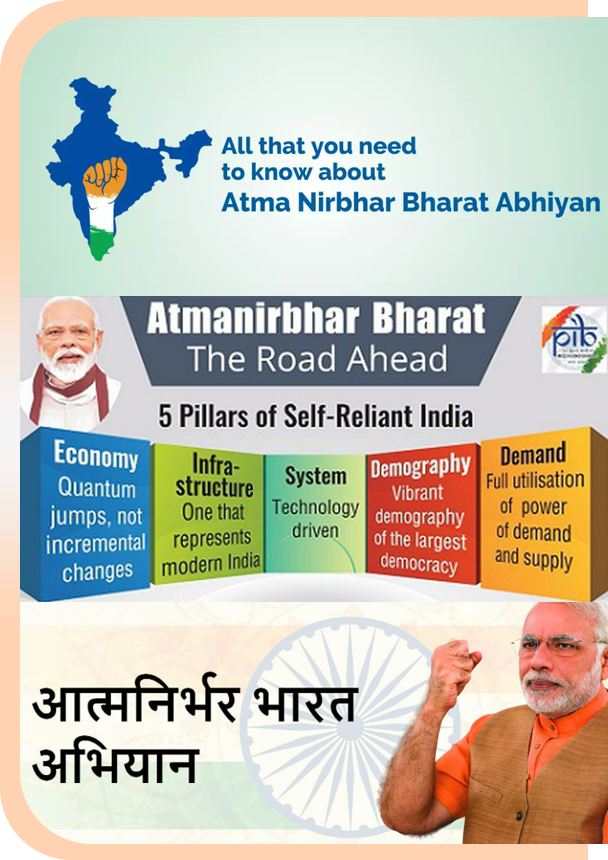
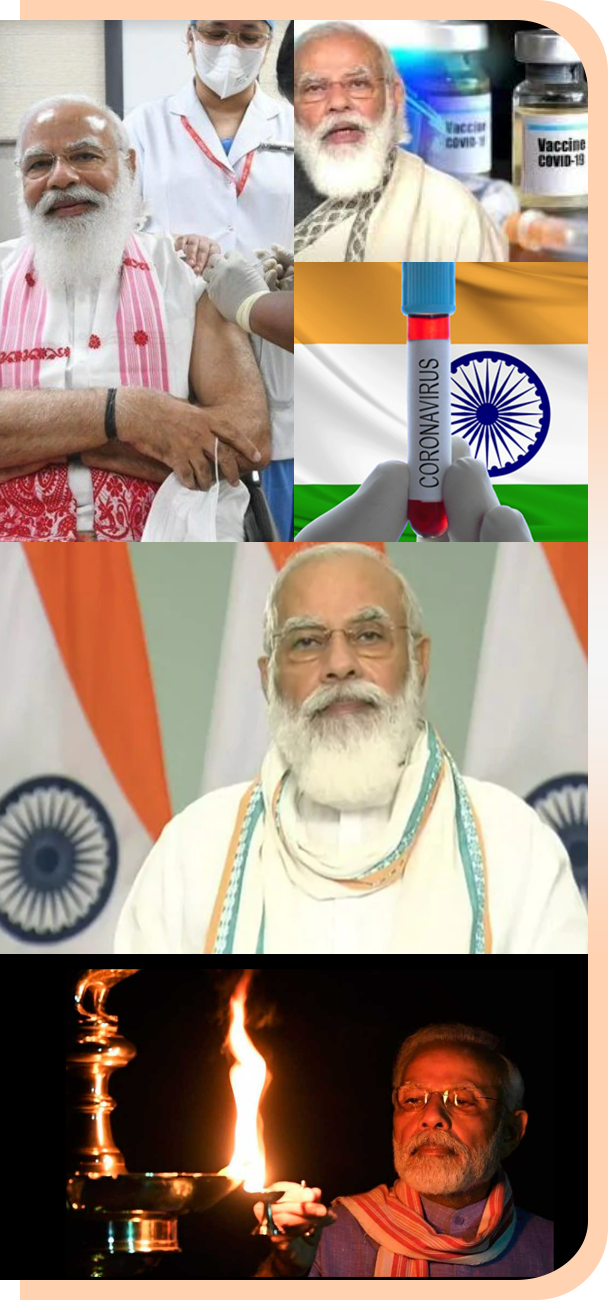
Fight against Covid 19:
Government of India under the leadership of Shri Modi ji is continuously taking all necessary steps to ensure that we are prepared well to face the challenges & threats posed by the growing pandemic of Covid-19. The most important factor in preventing the spread of virus locally is to educate & empower the citizens with correct information & taking the requisite precautions as per the advisories issued by Ministry of Health & Family Welfare. The Govt under Shri Modi’s leadership dealt effectively with the Covid-19 Situation. Introduction of emergency helplines, apps like aarogya setu for people to monitor the status of Covid in the country and around them. Availability of vaccination, easy access to all, provision of online registration facilities like Cowin registration portal, Aarogya Setu Registration, Umang: The spirit of New India. Provision of Helpline numbers for Child helpline, Mental Health, Senior Citizen, Ayush Covid Counselling, etc. COVID vaccination in the country commenced with vaccination to all Health Care Workers.
The program was expanded with time to include vaccination of Front Line Workers, citizens more than 60 years of age, citizens more than 45 years of age and eventually citizens more than 18 years of age. Under the National COVID Vaccination Program, from 16th January to 30th April 2021, 100% of vaccine doses were procured by Government of India and provided free of cost to State Governments. State Governments were in turn to administer vaccination free of cost to defined priority groups. To increase the pace of vaccination, participation of private hospitals was also enlisted where individuals could also chose to get vaccinated at a prescribed rate. India achieved a major milestone in its vaccination programme against COVID-19 as the cumulative doses administered surpassed the 200-crore mark. Like the first and second doses, precaution/booster doses will also be given free to people above 18 years & 59 years of age at all govt COVID vaccination centers.
Fight against Covid 19:
Shri Narendra Modi is a ‘People’s Leader’, dedicated to solving their problems and improving their well-being. Nothing is more satisfying to him than being amongst the people, sharing their joys and alleviating their sorrows. His powerful ‘personal connect’ with the people on ground is complemented by a strong online presence. He is known as India’s most techno-savvy leader, using the web to reach people and bring about change in their lives. He is very active on social media platforms including Facebook, Twitter, Instagram, Sound Cloud, Linkedin, Weibo and other forums. Beyond politics, Narendra Modi enjoys writing. He has authored several books, including poetry. He begins his day with Yoga, which strengthens his body and mind and instills the power of calmness in an otherwise fast-paced routine.
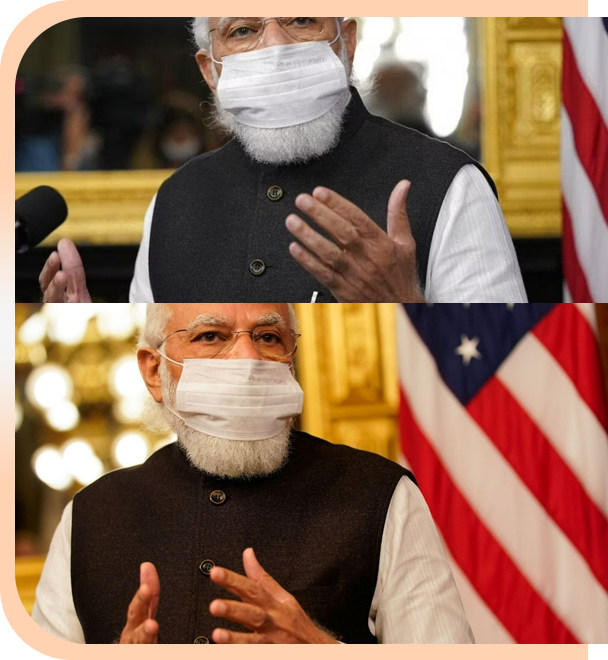
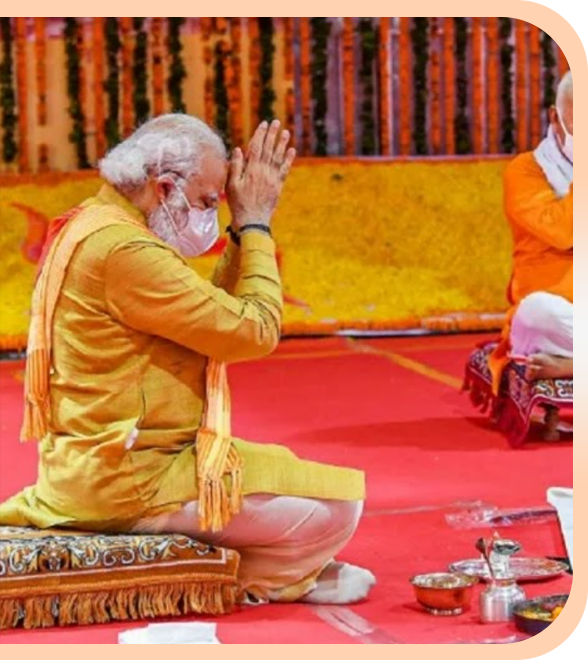
Ram Mandir at Ayodhya:
The In November 2019, the Supreme Court delivered its verdict favouring the construction of Ram Mandir at the disputed location. The government has set up a trust named Shri Ram Janmbhoomi Teerth Kshetra for construction of the Temple at the location. After the ruiling was out, UP Governor Anandiben Patel, Chief Minister Shri Adityanath Yogi, The chief of RSS Shri Mohan Bhagwat, Head of Shri Ram Janmbhoomi Teerth Kshetra Trust Shri Nritya Gopal Das along with PM Shri Narendra Modi ji performed the rituals & PM performed the ground breaking ceremony for the temple in Ayodhya.
Triple Talaq:
Supreme Court\ on 22nd August, 2017, in a majority judgement set aside the practice of divorce by pronouncing instant Triple Talaq as violative of Article 14 of the Constitution. Lok Sabha passed the Muslim Women (Protection of Rights on Marriage) Bill, 2019 on 25th July, 2019 and the Rajya Sabha also passed it on 30th July, 2019. After receiving the approval of the President of India, The Muslim Women (Protection of Rights on Marriage) Act, 2019 came into force from the 19th of September 2018.
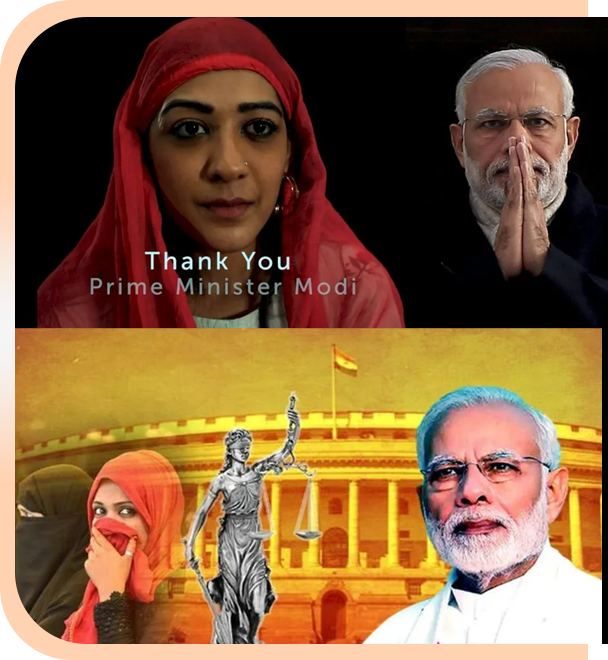
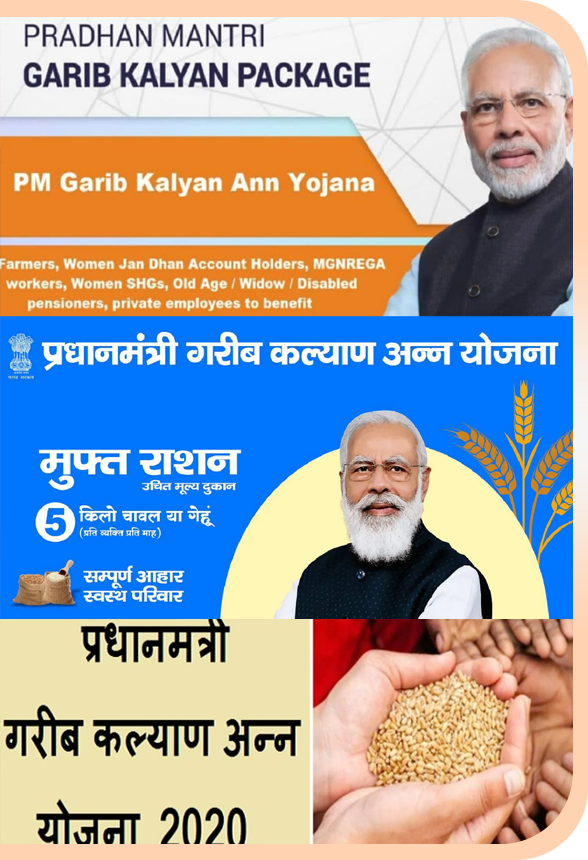
PM Garib Kalyan Yojna:
In 2016, the Govt. of India launched Pradhan Mantri Garib Kalyan Yojana as a part of the Taxation Laws Act 2016. The initial objective of the scheme was to ensure tax evaders declare their unaccounted money and avoid penalty and criminal prosecution. Through this scheme, the govt. intended to use the deposited black money for welfare of the poor people. The scheme was valid from December 2016 to March 2017. In 2020, the govt. extended the scheme to include relief packages during the pandemic. The aim was to support livelihood of poor during COVID-related lockdowns. The central govt. provided entire employee EPF contributions (12% of the total wages) and employers’ EPF & EPS contributions (12% of wages), totalling 24% of the monthly wages for three months. A relief package worth Rs. 1.70 lakh crore was announced by the Union Finance & Corporate Affairs Minister Ms. Nirmala Sitharaman under the PMGKY.
Bharatmala Pariyojana
It is an umbrella program for the highways sector that focuses on increasing the efficiency of freight and passenger movement across the country by developing the required infrastructure for development of Economic Corridors, Inter Corridors and Feeder Routes, National Corridor Efficiency Improvement, Border and International connectivity roads, Coastal and Port connectivity roads and Green-field expressways. The scheme was announced by Shri Nitin Gadkari, in the presence of the Prime Minister Shri Narendra Modi. All key aspects of the scheme will be managed by the Road Transport and Highways Ministry of the country.
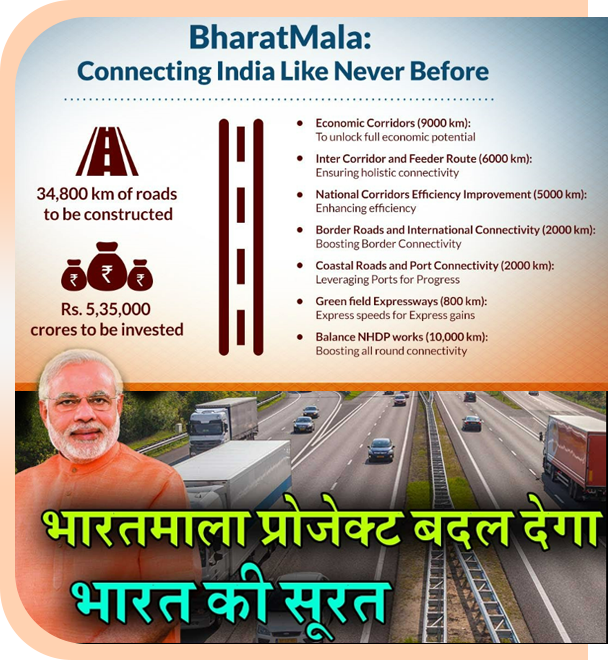
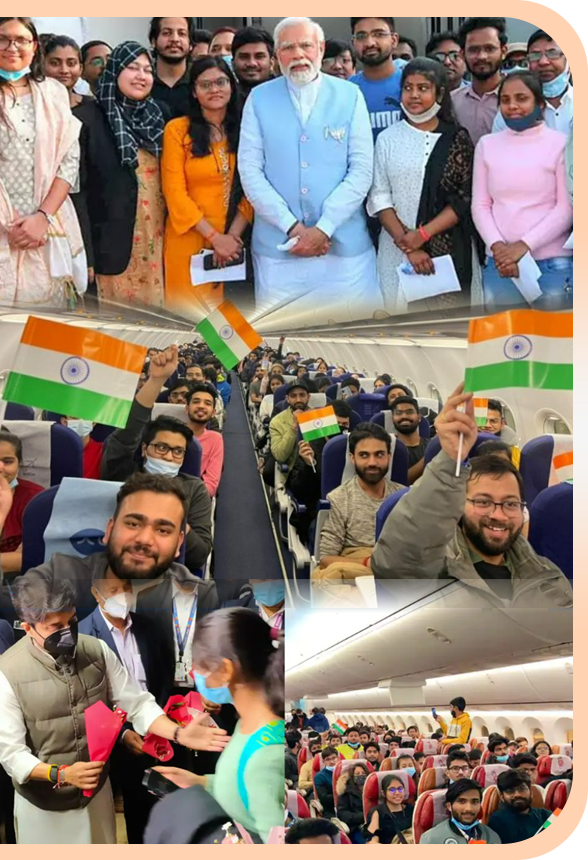
Operation Ganga
It was an evacuation mission undertaken by Govt of India to bring back all the Indian nationals were stuck amidst Ukarain-Russia war crises. The Indian evacuation flights operated from neighbouring countries like Romania and Hungary. The government also facilitated evacuation of stranded Indians from its borders crossing Romania, Hungary, Poland and Slovakia. This operation was dedicated to provide all kinds of assistance to Indian students and citizens stuck in the war zone. The Government shared travel advisory. Prime Minister Narendra Moji mentioned the visit of four special envoys to different nations from where the evacuation had been carried out, in a high-level meeting for Operation Ganga. Ministry of Health and Family Welfare was coordinating with the Ministry of Aviation, the Ministry of Home Affairs, and the Ministry of External Affairs for vacating Indians from Ukraine. 1156 Indians had safely arrived in India from Ukraine as of 28th February 2022.
Shri Narendra Modi is a ‘People’s Leader’, dedicated to solving their problems and improving their well-being. Nothing is more satisfying to him than being amongst the people, sharing their joys and alleviating their sorrows. His powerful ‘personal connect’ with the people on ground is complemented by a strong online presence. He is known as India’s most techno-savvy leader, using the web to reach people and bring about change in their lives. He is very active on social media platforms including Facebook, Twitter, Instagram, Sound Cloud, Linkedin, Weibo and other forums. Beyond politics, Narendra Modi enjoys writing. He has authored several books, including poetry. He begins his day with
Yoga, which strengthens his body and mind and instills the power of calmness in an otherwise fast-paced routine.

